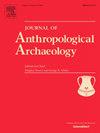史前朝鲜木门聚落的族群内部社会分化和家庭不平等
IF 2.2
1区 社会学
Q1 ANTHROPOLOGY
引用次数: 0
摘要
本研究使用基尼指数和洛伦兹曲线考察了朝鲜半岛南部73个木门聚落(约公元前1500-1年)的聚落内部社会不平等。房屋大小和陶器密度分别作为社会经济实力和食物储存和分享能力的代表。分析揭示了对木门社会复杂性的细致理解。房屋大小的差异显示出较低的基尼系数,这表明群体内部存在一定程度的平等主义关系。然而,公共基础设施,如水田系统、防御结构和石碑,表明社区范围内的合作和管理领导的存在。此外,陶器密度的显著高基尼系数表明,在工艺等因素的推动下,家庭间的经济不平等更大。这些观察结果共同表明,木门的定居关系是建立在平等原则的基础上的,人们合作实现共同的目标和利益,同时寻求以家庭为基础积累财富。总体而言,住区数据集表明,木门社会关系包含平均主义和日益复杂的因素,尽管数据并未表明住区内部社会不平等随着时间的推移而加剧。本文章由计算机程序翻译,如有差异,请以英文原文为准。
Intragroup social differentiation and household inequality in prehistoric Mumun settlements of Korea
This study examines intra-settlement social inequality across 73 Mumun settlements (ca. 1500–1 BCE) on the southern Korean Peninsula using the Gini index and Lorenz curve. House size and pottery density are employed as proxies for socioeconomic power and the capacity for food storage and sharing, respectively. The analysis reveals a nuanced understanding of Mumun social complexity. Variations in house sizes show low Gini scores, suggesting a degree of egalitarian intragroup relationships. However, communal infrastructures, such as paddy field systems, defensive structures, and dolmens, indicate community-wide collaboration and the presence of managerial leadership. Furthermore, the significantly high Gini scores for pottery density demonstrate greater inter-household economic inequality, driven by factors such as craftsmanship. These observations collectively suggest that Mumun intra-settlement relationships were founded on principles of equality, with people collaborating to achieve common goals and benefits while seeking to accumulate wealth on a household basis. Overall, the settlement datasets indicate that Mumun social relations contained elements of both egalitarianism and increasing complexity, although the data do not indicate that intra-settlement social inequality intensified over time.
求助全文
通过发布文献求助,成功后即可免费获取论文全文。
去求助
来源期刊

Journal of Anthropological Archaeology
Multiple-
CiteScore
4.00
自引率
11.10%
发文量
64
期刊介绍:
An innovative, international publication, the Journal of Anthropological Archaeology is devoted to the development of theory and, in a broad sense, methodology for the systematic and rigorous understanding of the organization, operation, and evolution of human societies. The discipline served by the journal is characterized by its goals and approach, not by geographical or temporal bounds. The data utilized or treated range from the earliest archaeological evidence for the emergence of human culture to historically documented societies and the contemporary observations of the ethnographer, ethnoarchaeologist, sociologist, or geographer. These subjects appear in the journal as examples of cultural organization, operation, and evolution, not as specific historical phenomena.
 求助内容:
求助内容: 应助结果提醒方式:
应助结果提醒方式:


